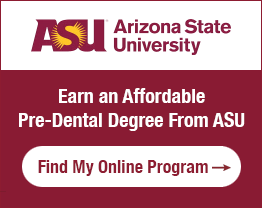The Minnesota Department of Employment and Economic Development reported a total of 1,383 licensed dental hygienists working in the state as of 2012. The Department projects that in the years leading up to 2022 there will be an increase of 31 percent in the number of dental hygienist jobs available in the state.
Dental hygienists in Minnesota are permitted to perform patient screenings, take and develop dental x-rays, remove calculus and plaque, and counsel patients about nutrition and the importance of good oral health.
Featured Programs:
- Online
The Minnesota Board of Dentistry, which is responsible for regulating and licensing dental hygienists in Minnesota, will require you to meet specific education and exam requirements to be eligible for licensure.
To learn how to become a dental hygienist in Minnesota, complete these steps:
Step 1. Graduate from an Accredited Dental Hygiene School
To become a dental hygienist in Minnesota, you must graduate from one of the state’s dental hygiene schools that have been accredited by the Commission on Dental Accreditation (CODA). CODA is the only accrediting body for dental hygienist programs in the U.S. It is part of the American Dental Association and is recognized by the U.S. Department of Education.
A CODA-accredited program may be offered at the associate (A.A., A.S., or A.A.S.) or bachelor (B.S.) degree level, although the minimum requirement for licensure is an associate’s degree.
Bachelor’s degrees are also a popular choice in this field, as they may provide additional opportunities for advancement and supervisory positions, as well as jobs in research and higher education. The completion of a bachelor’s degree will also prepare you to pursue graduate work.
The Board maintains a list of approved dental hygiene programs in Minnesota, as well as programs in the nearby states of South Dakota, North Dakota, Wisconsin, and Iowa.
Step 2. Pass the National Board Dental Hygiene Examination
You must take and pass the National Board Dental Hygiene Examination (NBDHE) within 5 years of applying for licensure as a dental hygienist in Minnesota.
The NBDHE is a standard assessment tool for all state boards of dental examiners in the U.S. It was designed by the Joint Commission on National Dental Examinations (JCNDE), an independent agency of the American Dental Association (ADA).
The NBDHE, a written examination, is designed to assess a candidate’s knowledge of the dental hygiene sciences and the biomedical sciences. It also involves a number of case-based assessments.
The NBDHE is administered through Pearson VUE testing centers. You can schedule to take the examination once you have applied for registration through the JCNDE. In Minnesota, you may take the examination at Pearson VUE testing centers located in: St. Paul, Hermantown, Brooklyn Park, Bloomington, and Rochester.
Step 3. Take and Pass a Recognized Clinical Examination
Upon the successful completion of the National Board Dental Hygienist Examination, you must take and pass an approved clinical examination. Currently, the Minnesota Board of Dentistry recognizes the following regional state board clinical examinations for licensure as a dental hygienist:
The Board accepts the North East Regional Board (NERB) of Dental Examiners if you passed it between 2002 and November 30, 2009.
Step 4. Take and Pass the Minnesota Jurisprudence Examination
You must take and pass the Minnesota Jurisprudence Examination before you apply for licensure. To prepare to take the examination, you will need to study two publications:
- The Minnesota Dental Practice Act, which can be purchased through the Minnesota BookStore. You may also access the required information on the Board’s website (under Board Statutes and Rules).
- The current CDC guidelines, which can be found on their website
Prometric, Inc. administers the Minnesota Jurisprudence Examination in a number of locations in Minnesota. You must register to take the exam through Prometric.
Step 5. Apply for Licensure to Practice Dental Hygiene in Minnesota
Once you have completed all necessary requirements for licensure, you must complete the Application for Licensure by Examination to Practice Dental Hygiene and enclose the following:
- $120.50 fee (application fee of $55, the OET fee of $5.50, and the initial fee of $60), made payable to the Minnesota Board of Dentistry
- A notarized copy of your National Board certificate or card
- A notarized copy of passing an approved regional clinical examination
- An original or notarized copy of proof of passing the jurisprudence examination
- A photocopy of your current CPR certification
Permit to Administer Nitrous Oxide Inhalation Analgesia
You may also apply for a permit to administer nitrous oxide inhalation analgesia with your application for licensure, provided you complete the attached application form. To qualify to administer nitrous oxide inhalation analgesia, you must:
- Complete a course on the administration of nitrous oxide inhalation analgesia from a CODA-accredited institution; the course:
- Must include a supervised clinical experience using fail-safe analgesia equipment capable of positive pressure respiration
- Must include personally administering and managing at least 3 individual, supervised cases of analgesia
- Must include at least 12 hours of didactic instruction
Step 6. Maintain your Minnesota Dental Hygienist License
All dental hygienists in Minnesota must renew their licenses biennially upon the completion of at least 25 continuing education credits. Of those required credits, 15 must be in fundamental dental hygiene areas and 10 may be elective courses. A CPR certification course is also mandatory to maintain your license.
Further, at least two courses must be completed in two different core subject areas during each renewal cycle:
- Infection control
- Record keeping
- Ethics
- Management of medical emergencies
- Patient communication
- Diagnosis and treatment







